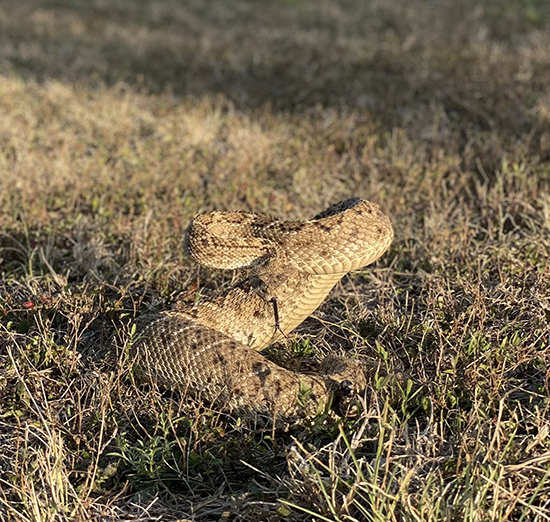
THE SOUTH TURKEY HUNTING ZONE opened last Saturday; North Zone opens April 1. Watch the weather, it’s ever changing in spring. And watch where you’re going and sitting. You’re invading hostile territory. Turkeys don’t bite, but snakes sure do! Some reports mention rattlesnakes that don’t rattle before striking. TPWD says no scientific study confirms this, but they don’t doubt it. Pictured is a diamondback from Kerr County photographed by Fred Sherron, Jr. a few miles northwest of one of the papers carrying this column, The West Kerr Current in Ingram. (Submitted Photo)
by John Jefferson
Once, the only wild turkeys legally killed by Texas hunters were Rio Grande turkeys. They were shot in the fall by deer hunters. Few hunters went afield primarily hunting turkeys. Most gobblers were shot with rifles.
About 1970, an experimental spring turkey season was established in Kerr, Kimble, and Sutton counties. The highly successful experiment led to the supremely popular season for Rio Grandes now enjoyed in many counties. A short season in twelve East Texas counties for eastern turkeys opens April 22 – May 1.
BUT be cautious – It’s also snake season!
The western diamondback rattlesnake (Crotalus atrox) is the most common of the four venomous snakes in Texas, and probably the most numerous. It’s most likely to be encountered, and most feared. After all, its scientific name means “frightful”. Several other rattlesnake subspecies also exist here.
The other three species of venomous snakes are copperheads, cottonmouths, and coral snakes. Coral snakes have the deadliest venom but the fewest reported bites on humans. Their mouths require that they need to practically gnaw on a human or pet. Non-poisonous kingsnakes are often mistaken for coral snakes since the bands going around their bodies are similarly red, yellow, and black. If the red and yellow bands are touching — Look Out! “Red and yellow, KILL a fellow; red on black, venom LACK!”
Cottonmouths are a different story. They usually hang out around water, are usually aggressive, and are black and ugly. A friend in high school nearly died from bites (plural!) from one while swimming in a rice canal.
Copperheads are dangerous since they often lie camouflaged in leaves or low brush and are hard to see. Their coloration helps them blend in. They are profuse in East Texas, but found in much of the rest of the state, too.
Back to turkey hunting, a female friend sat against a tree in the dark. Feeling the need to answer Nature’s call before daylight and knowing turkey hunters must remain still, she decided to deal with it before hunting time. She felt a scratch on her back side and thought it was a stick or greenbrier. Later, when the hot water in the shower struck her back, she let out a scream. She told me tissue sloughed off for several months. Probably a copperhead.
A friend, Horace Gore, stopped on the trail to listen for gobbles and felt something on his boot. He thought it was a stick. As Gore started to move on, he looked down and saw a small rattlesnake strike his boot a third time. He was lucky; the bites didn’t penetrate his boot. And since he didn’t want to spook the turkeys, the snake was lucky, too.
Rattlers are moving to find mates in the spring – and that’s NOW!
Tagging/reporting rules for turkey hunters, new county alignment for the North and South turkey zones, and hunting prospects are in the TPWD Outdoor Annual and the online app: https://tpwd.texas.gov/regulations/outdoor-annual/
Mucho information! Be sure you check the county in which you hunt!
JJ



